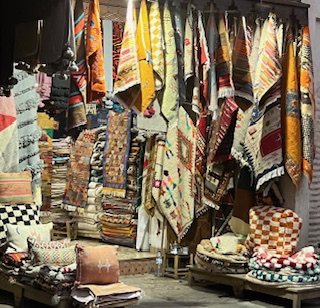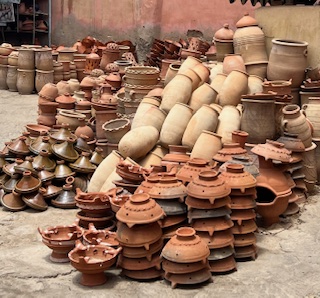An Ode to Morocco and Traditional Craftsmanship
- Lisa Horowitz
- Feb 14, 2024
- 3 min read

Many of you know that I am smitten with Morocco. My husband and I have travelled there many times and were so enamored of the country that we bought a riad in the old city (medina) of Marrakesh. (And please bear with me for a marketing plug: when we are not in Morocco, we are renting our riad through Airbnb and you can find it here.) Morocco is a source of inspiration or a "muse" for me. Several of the mosaic pieces in my Portfolio (Voyages) are based on photos and images from my visits and adorn the walls in our riad.
Why Morocco? I sketched out a quick answer to that question on my last trip and posted it on Instagram:

Visually Morocco is always a treat- the colors are vibrant and the architecture and people in the old city are so different from my everyday life at home that they call on me to look and pay attention. Picturesque images abound! One of the aspects of life in Morocco that feels most appealing is the artisanship one sees everywhere. Throughout the medina, people are engaged in traditional crafts, making items that are not only serviceable but beautiful. While we have had occasion to purchase necessities like plastic food containers, extension cords, or mops, most of what we buy is hand-made and exquisite. A coffee mug is from local clay, hand-thrown and individually painted. Lamp shades are from hammered metal, stamped and cut out right down the block from our riad. Berber blankets are bought from a local shop near our home where we know the owner and are warmly greeted and offered mint tea when we walk by. Crafts are typically grouped by neighborhood within the medina so that one finds many leather artisans working in close proximity, baskets and straw objects in one square or covered alleyway, or metal workers in an area of garages or industrial spaces marked "Metal Artisans." Such groupings reflect the tradition of medieval craft guilds which are intermingled with newer stores. If an item cannot be found in one stall, often the owner will run over to another stall to locate it, in a spirit of sharing and cooperation. Around each corner are craftspeople working in wood, plaster, metal, clay, wool, and straw and using techniques that have been handed down over generations. People take pride in the distinctive style of their work, which also reflects their geographic location and their history.
Among the best known of Moroccan crafts is ceramics and the most familiar is the blue and white pottery originating in the city of Fez. The tradition in Fez dates back to the Phoenicians but the style known today has its roots in the late 15th century when Arabs and Jews were forced out of Andalusia in Spain. The clay in Fez is fine in texture and grey rather than terracotta, which is more common further south, making it a perfect backdrop for white glaze and cobalt decoration. The rich blue color is an oxide of cobalt and copper known as le Blue de Fes. Patterns are generally Islamic or Moorish in origin.

In contrast, green pottery originates from Tamegroute, a small village at the edge of the Sahara where seven families of artisans have been passing down techniques and formulas for generations. The signature green glaze contains a type of rock from local mines, along with a mixture of other minerals whose precise combination is secret. The resulting multi-shade green color never fades and has yet to be replicated anywhere else.

And for a visual treat, here are some examples of stunning older pottery from museums in Marrakech, reflecting the durability and artistry of the craft:
_edited.png)





















Comments